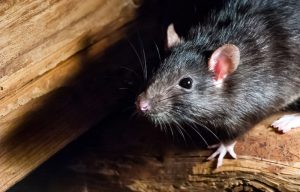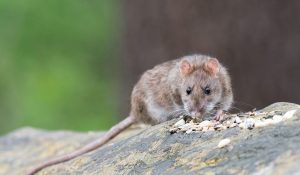You’ve worked hard to cultivate a beautiful yard, but suddenly it’s full of unsightly holes. Now, you’re wondering what animal is digging holes in your yard and how to stop the damage.
Don’t worry – we’ve got the answer for you!
At Smith’s Pest Management, we help people eliminate destructive, damaging pests daily in the San Francisco Bay Area, so we know how to help people reclaim their yards and prevent further damage.
In this blog, we’ll help you identify which animals are digging holes in your yard and share strategies to stop them.
Key Takeaways
- The most common types of animals that dig holes in yards are skunks, groundhogs, moles, pocket gophers, voles, raccoons, wasps, and earthworms, among others.
- If burrowing animals are destroying your yard, the first step is identifying which kind of animal is responsible for the damage.
- Once you’ve identified the animal digging the holes, you can stop the digging through a combination of habitat modification and traditional methods, like trapping and baiting.
- If the digging problem persists, you may need to hire a professional pest management company to reclaim your space.
Why Do Animals Dig Holes in Yards?
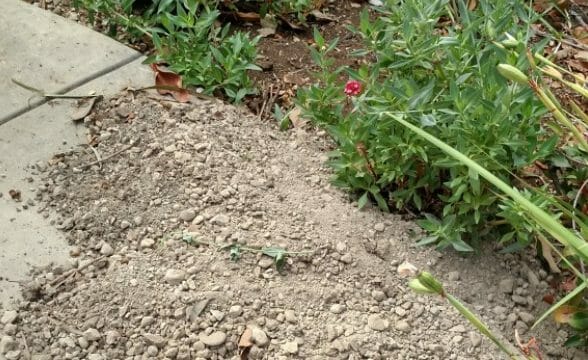
Generally speaking, animals that dig holes in your yard are doing so because they’re looking for food or seeking nesting or shelter locations.
Here’s a quick breakdown of each:
1. Food
Often, animals dig holes to find food. For example, burrowing rodents like moles and gophers usually dig because they’re looking for worms, grubs, insects, and vegetation.
How do you determine if animals are digging for food in your yard? Look for a grub infestation. To do this, cut a 12”-large piece of sod and pull it back.
If you have grubs, you’ll be able to see their light-colored bodies wiggling around in the dark soil underneath. In this case, having your yard treated for grubs is a great way to start dealing with the digging.
To identify earthworm infestations that could be drawing pests, look for 1” high piles of granular pellets surrounding pencil-sized holes. These holes signify high numbers of earthworms, which could be attracting digging rodents.
Finally, some digging rodents eat vegetation, like ornamental plants and vegetables. If you have a vegetable garden or you’ve noticed signs of rodent predation (like gnawing and girdling) on your ornamental plants, it’s a good sign that the rodents who are digging in the area are also feasting on your plants.
2. Shelter
Other digging animals, like skunks, tunnel through moist, loose dirt to create burrows and runways where they can live, breed, and store food.
If an animal is digging for shelter, you’ll usually find burrows under solid objects, like your home’s foundation, patio, or fence lines, in addition to holes in your yard.
3. Nesting
Most digging animals, including ground squirrels, moles, and voles, build extensive networks of underground tunnels, many of which contain nests for rearing babies.
In many cases, these animals will build nests in one area of your property (maybe under your patio or deck or near your home’s foundation) and dig exit holes that pop up in your yard.
How Do Burrowing Animals Damage Yards?
While they may be small, digging pests can wreak havoc on yards in the following ways:
- Soil instability and shifting. Burrowing animals often create extensive networks of tunnels and burrows, which can undermine the soil and lead to erosion, soil instability, and shifting. If their burrows are near structures like a shed or your home’s foundation, this can lead to building damage and expensive repairs.
- Grass damage. Burrowing pests like raccoons, gophers, and voles are famous for damaging grass. While voles leave telltale “runways” in the grass, gophers tear up the grass, and raccoons pull up entire chunks of sod as they dig.
- Dirt mounds. Dirt mounds created by moles, gophers, and even earthworms can be unsightly. In some cases, however, they can also be dangerous. Some dirt mounds are large enough to interfere with lawn mowing equipment or create a tripping hazard.
- Garden damage. In addition to eating grass, tearing up sod, leaving dirt mounds, and creating runways, digging animals often destroy flower and vegetable gardens. Young vegetation is particularly at risk, although some b burrowing animals will pull entire plants into their burrows from below.
12 Types of Animals that Dig Holes in Yards
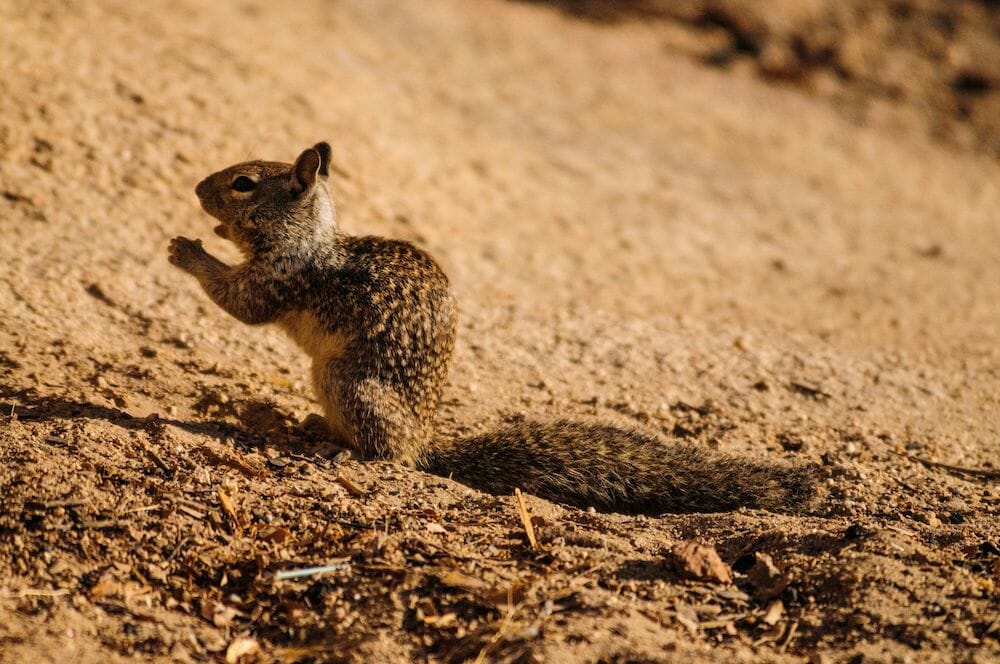
To determine which are responsible for the damage in your yard follow this identification guide.
For your convenience, we’ve listed these digging pests according to the size of the holes they create – from smallest to largest:
If you notice visible, small holes…
Look at the damage in your yard. If the disturbance has a visible hole between the size of a quarter and a softball, the pest is likely one of the following:
1. Earthworms
- Earthworms can make surprisingly large holes in the ground.
- To identify earthworm damage, look for 1” high piles of granular pellets of soil surrounding the entrance of pencil-sized holes.
- The telltale granular pellets at the entrance of earthworm holes are worm castings and can help you differentiate earthworm damage from damage caused by other animals.
2. Cicada Killer Wasp
- Cicada Killer Wasps create tiny holes that are smaller than a quarter.
- The holes they dig feature a u-shaped entry channel.
- They like well-drained, light soil in full sunlight and commonly dig alongside sidewalks, patio edges, or flower beds.
3. Voles
- Unlike other digging pests, voles create telltale runways – 1-2” paths on the surface of your turf.
- The holes they create are not mounded and tend to appear near concrete foundations, walkways, and slabs.
- Most vole holes are neat, round, and between ¾”-2” across.
- If vole numbers are high, or voles are reusing old pocket gopher tunnels, the holes they dig may be larger than 2”.
4. Pocket Gopher
- Pocket gophers are famous for doing extensive damage to yards, including digging, chewing electric wiring, and destroying sprinkler and utility lines.
- To identify gopher damage in your yard, look for mounds of dirt near entry holes that are about 2-3” wide.
- Gopher holes tend to feature horseshoe-shaped fanning of the soil near the hole.
5. Eastern Chipmunk
- Eastern chipmunks create holes that are slightly larger than the size of a golf ball.
- Chipmunk burrow entrances are about 2-3” in diameter.
- Unlike gopher holes, chipmunk holes are not mounded.
- These holes are connected to underground burrows.
6. Ground Squirrels
- Ground squirrels create extensive networks of interconnected burrows.
- They love to burrow beneath solid structures, like concrete foundations and slabs.
- Ground squirrel holes feature soil mounding.
- Most ground squirrel holes are 4-5” in diameter.
- These holes are connected to underground burrows about 2.5-4’ deep and roughly 5-35’ long.
- In addition to digging holes, ground squirrels will damage your garden and lawn near the entrances to their holes.
If you notice large holes…
While some animals create small holes, these pests create larger, more noticeable holes marked by large entrances or extensive mounding:
7. Moles
- Moles create holes that are about 2” in diameter.
- Their holes are always marked by conical mounds of soil.
- Mole holes will likely be marked by raised tunnels in the lawn.
8. Norway Rat
- Norway rats create holes that are 2-3” in diameter.
- These holes are connected to underground burrows.
- They tend to burrow near foundations, gardens, and sheds.
- They like to cluster their holes near buildings or structures.
9. Skunks
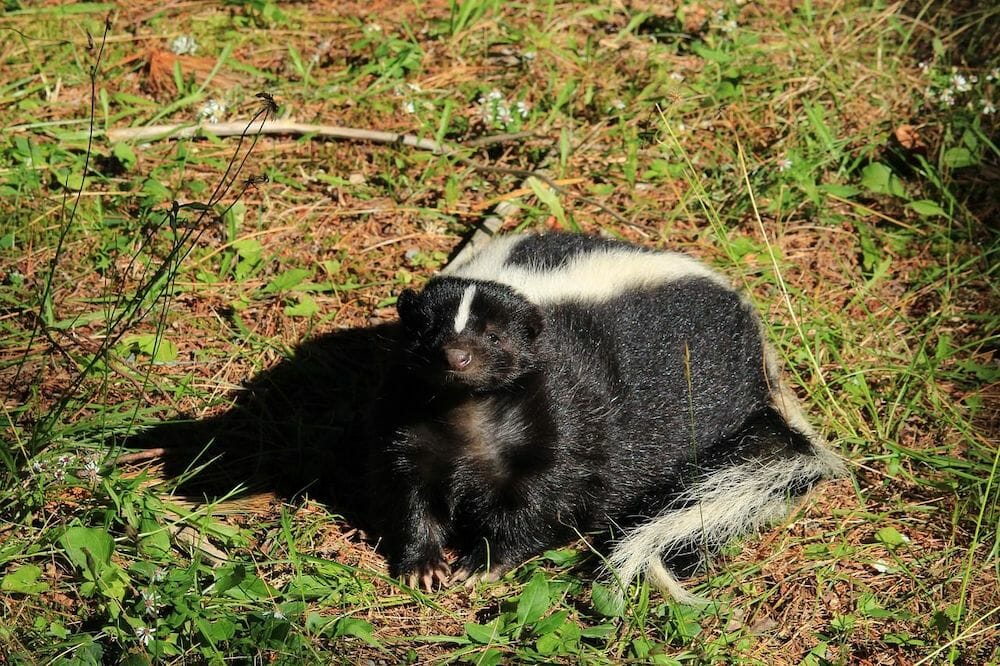
- Skunks dig holes to search for food and, along with raccoons, are the pest most likely to be digging holes in your yard at night.
- To identify skunk damage, look for cone-shaped holes that are 3-4” in diameter.
- Skunk holes are usually surrounded by a ring of loose soil.
- Skunks like to burrow under foundations, buildings, and porches in search of shelter.
10. Raccoons
- Unlike other digging animals, raccoons don’t build underground burrows.
- Instead, they dig in search of food.
- Raccoon damage usually features chunks of sod that have been pulled out and flipped over.
- Raccoon holes are cone-shaped, shallow, and about 3-4” in diameter.
11. Groundhogs
- Groundhog holes are larger than softballs and about 10-12” wide.
- Most groundhog burrow openings are marked by a crescent-shaped mound of dirt.
- Because they’re so large, groundhog holes can cause soil shifting and structural damage.
12. Snakes
- Snake holes can be challenging to identify because snakes generally do not dig their own burrows.
- Instead, they use old rodent nests, burrows, and holes.
- Snakes are most likely to live in a leftover mole or vole holes.
- To determine whether snakes are present, look for droppings with white ends, or shed snakeskin.
How to Stop Animals From Digging Holes
Now that you’ve determined which animals are digging in your yard follow these tips to stop them:
Earthworms
Earthworms are beneficial creatures that provide your lawn with natural aeration and fertilizer. What’s more, earthworm infestations usually won’t harm your lawn.
Because of that, we don’t recommend eliminating earthworms. If earthworm damage is bothering you, though, focus on habitat modification.
Here’s how:
- Adjust your watering routine to provide your lawn with 1-1.5” of water each week.
- Use a dethatcher to remove thatch buildup from your lawn.
- After a heavy rainstorm, manually remove worms that wiggle to the surface.
- Introduce natural predators, like birds.
- Reduce soil amendments like compost topdressing.
Cicada Killer Wasp
Cicada killer wasps are unlikely to sting, so homeowners can usually remove them safely by applying insecticidal dust around burrow entrances.
For the most comprehensive results, we recommend choosing an insecticide containing Cypermethrin, a synthetic pyrethroid that kills larvae and adults.
Voles
If you want to eliminate voles, we recommend using a combination of approaches.
Habitat modification efforts, like removing vegetation, and using mesh or plastic tubing to protect the trunks of young trees, can help.
We also recommend pursuing humane, conventional removal methods, like chemical vole repellents and traps.
To learn more about how to get rid of voles, check out our complete guide here.
Pocket Gopher
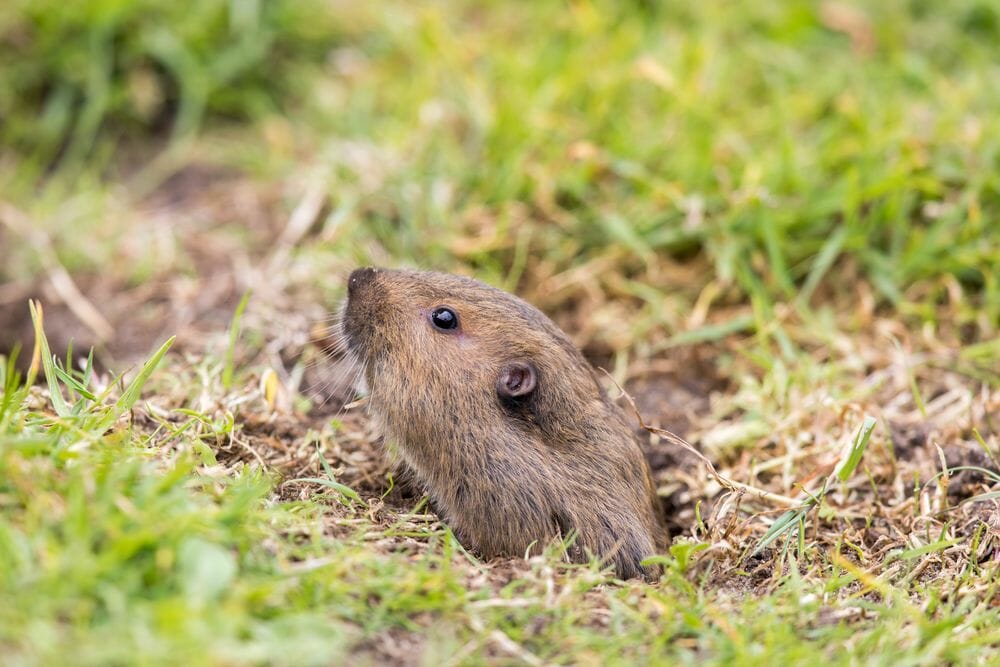
You’ll need to employ a comprehensive approach to stop pocket gophers from digging in your yard.
Here’s what we recommend:
- Start by installing exclusion fencing to protect vulnerable areas of your yard. The fencing should be made from wire mesh with openings of less than ½” x 1”.
- Remove weeds from the borders of your garden and yard.
- Install gopher wire in the bottom of your garden beds, and plant trees and vegetables in wire gopher baskets.
- Use trapping and baiting to suppress gopher populations.
To learn more about how to get rid of gophers, check out our complete guide here.
Eastern Chipmunk
Use the same habitat modification tactics as you would with gophers and voles to stop chipmunks from burrowing in your yard.
Other options, like baiting with treated grain, can be effective during the summer and fall.
During the spring, burrow fumigation is an excellent way to remove chipmunks and prevent re-infestation.
You can also prevent subsequent invasions by destroying old burrows. Use a ripping bar to rip vacant burrows to a depth of at least 20” for best results.
Ground Squirrels
To stop ground squirrels from digging in your yard, we recommend a combination of cultural and biological control methods.
Here’s a quick breakdown:
- Modify the habitat to make it less attractive for ground squirrels. Remove rocks, wood piles, and debris piles, and plow deep lines along the perimeters of your fences to destroy ground squirrel burrow entrances.
- Establish a trapping program to reduce ground squirrel populations.
- Use baits that are effective at eradicating ground squirrels. Zinc phosphide and anticoagulants like diphacinone and chlorophacinone are popular options.
- Use fumigants in the early spring, when this treatment is most effective.
For a complete discussion of how to get rid of ground squirrels, check out our guide here.
Moles
Since moles usually dig holes in search of food, start by removing their food sources. Moles love grubs and earthworms, so reducing or eliminating these will help resolve mole infestations.
Here’s a quick guide to mole removal best practices:
- Use beneficial nematodes or milky spore to kill grubs without harming your yard.
- Dig trenches 2’ deep and 6” wide around the area you want to protect from moles.
- Avoid over-watering your lawn – limit watering to about 1” of water per week.
- Employ a trapping program to reduce mole populations.
- Use mole baits to remove infestations.
For more information about how to get rid of moles in your yard, check out our guide.
Norway Rat
To eliminate rats in your yard, modify the habitat by removing debris piles and food sources.
Pay special attention to snail populations since rats love to eat snails and will infest yards where high numbers of snails are present.
Next, employ a trapping program to kill rats immediately and follow-up with a long-term baiting strategy to prevent re-infestation.
For more information on how to get rid of rats in your yard (and home), consult our comprehensive guide, and check out this piece to learn more about the best rat traps on the market today.
Skunks
To get rid of skunks in your yard, focus on habitat modification. Skunks are nocturnal, and their eyes are highly sensitive to light.
Because of this, installing a motion-activated flood light can be enough to scare skunks away.
If that doesn’t work, contact a professional pest management company like Smith’s Pest Management to help you implement a humane trapping program to remove and relocate skunks.
Raccoons
Raccoons, like skunks, are nocturnal and usually dig holes in search of food.
To get rid of them, remove food sources by securing trash cans, installing exclusion fencing around fruit and vegetable gardens, and removing access to water sources.
Have your yard professionally treated for grubs, and install motion-activated lights and sprinklers to keep these pests away. For more information on how to get rid of raccoons, consult our guide.
Groundhogs
The best way to get rid of groundhogs and stop them from digging in your yard is to contact a professional pest management company for help with a humane trapping program.
Habitat modification, baiting, and repellents may also help eliminate groundhog populations.
Snakes
Because snakes don’t dig their own burrows, the best way to keep them out of your yard is to focus on preventing them from inhabiting abandoned rodent burrows.
The best way to do this is by eliminating food sources like rodents, lizards, slugs, and small birds, removing standing water and eliminating shelter like debris piles, leaf buildup, and wood piles.
For more information on getting rid of snakes in your yard, consult our guide on the topic.
Are Burrowing Animals Destroying Your San Francisco Bay Area Lawn or Garden? We can Help!
Burrowing animals can wreak havoc on your property, especially if they’re digging under concrete structures like your patio, sidewalks, or even your home’s foundation.
Fortunately, you don’t have to deal with infestations alone!
Here at Smith’s Pest Management, we help homeowners from Marin to Monterey remove burrowing rodent infestations daily.
We tailor our humane, eco-friendly removal efforts to your property and needs, so you can always enjoy effective, comprehensive pest removal.



